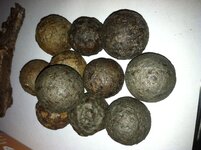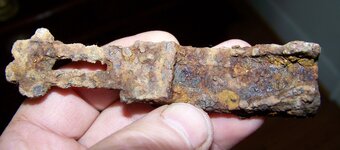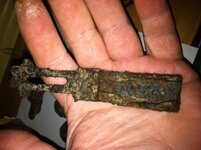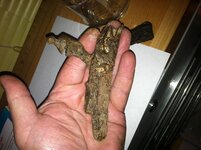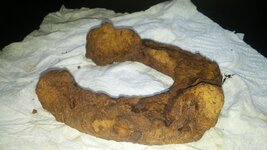- Jan 27, 2009
- 18,788
- 11,896
- 🥇 Banner finds
- 1
- Detector(s) used
- Tesoro Conquistador freq shift
Fisher F75
Garrett AT-Pro
Garet carrot
Neodymium magnets
5' Probe
- Primary Interest:
- All Treasure Hunting
On a whim I tried cleaning some Iron canister shot with white vinegar instead of using electrolysis. Here is what it looked like when dug.
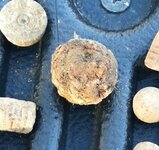
Next I used a cheap distilled white vinegar.
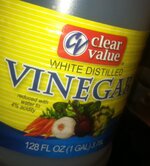
Let soak for 3 days in a coffee cup and lightly brushed it every day with a small wire brush like a tooth brush.
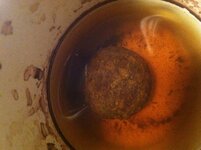
Final results with white distilled vinegar.
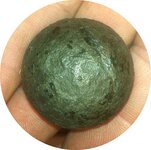
Electrolysis of an 1860 something Tenney English cast steel hatchet.
Before
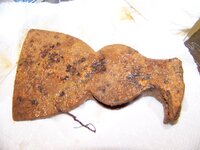
After electrolysis reveled writing for an I.D.
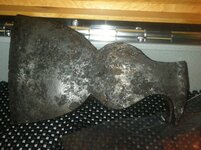
Four similar cannon canister shot soaked in Apple Cider Vinegar beside the one soaked with White distilled vinegar.
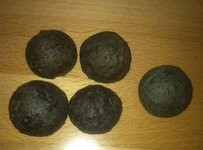
Conclusion
When using electrolysis you have to have a good contact and may have to drill a spot to get it cooking. You also have to watch it to keep from burning it up to much and you have to keep a close eye on the cleaning process.
Apple Cider Vinegar is expensive and just plain nasty stuff if you get it on anything. All vinegar will bubble to an extent but ACV was a mess to work with.
Distilled white vinegar is cheap. You do not have to stand over it and watch it. It seems to be kinder to the relic only removing the rust and not eating clean metal. I would not have thought the rusty canister shot would come as clean as it did and give the details of the seams. I plan on using it on a lock plate next and a trade axe and see how it goes. I did this in my kitchen and the smell was pretty un noticeable . I think the trick was to lightly brush the relic every day wearing gloves to help the vinegar penetrate.
Here are my results I am not saying do away with your electrolysis set up but give distilled white vinegar a chance on an item on no value and see what you think.
Happy Hunting!
TnMtns

Next I used a cheap distilled white vinegar.

Let soak for 3 days in a coffee cup and lightly brushed it every day with a small wire brush like a tooth brush.

Final results with white distilled vinegar.

Electrolysis of an 1860 something Tenney English cast steel hatchet.
Before

After electrolysis reveled writing for an I.D.

Four similar cannon canister shot soaked in Apple Cider Vinegar beside the one soaked with White distilled vinegar.

Conclusion
When using electrolysis you have to have a good contact and may have to drill a spot to get it cooking. You also have to watch it to keep from burning it up to much and you have to keep a close eye on the cleaning process.
Apple Cider Vinegar is expensive and just plain nasty stuff if you get it on anything. All vinegar will bubble to an extent but ACV was a mess to work with.
Distilled white vinegar is cheap. You do not have to stand over it and watch it. It seems to be kinder to the relic only removing the rust and not eating clean metal. I would not have thought the rusty canister shot would come as clean as it did and give the details of the seams. I plan on using it on a lock plate next and a trade axe and see how it goes. I did this in my kitchen and the smell was pretty un noticeable . I think the trick was to lightly brush the relic every day wearing gloves to help the vinegar penetrate.
Here are my results I am not saying do away with your electrolysis set up but give distilled white vinegar a chance on an item on no value and see what you think.
Happy Hunting!
TnMtns
Last edited:








